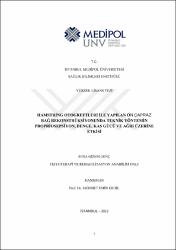Hamstring otogreftleri ile yapılan ön çapraz bağ rekonstrüksiyonunda teknik yöntemin propriosepsiyon, denge, kas gücü ve ağrı üzerine etkisi
Künye
Genç, S. G. (2019). Hamstring otogreftleri ile yapılan ön çapraz bağ rekonstrüksiyonunda teknik yöntemin propriosepsiyon, denge, kas gücü ve ağrı üzerine etkisi. (Yayınlanmamış yüksek lisans tezi). İstanbul Medipol Üniversitesi Sağlık Bilimleri Enstitüsü, İstanbul.Özet
Çalışmamızın amacı, ön çapraz bağ rekonstrüksiyonunda (ÖÇBR) tamamı içerde tekniğinin konvansiyonel tekniğe göre propriosepsiyon, kas gücü, ağrı ve denge açısından farklarını araştırmaktır. Çalışma, Medipol Mega Üniversite Hastanesi'nde tamamı içerde tekniğiyle ÖÇBR olan 20 kişi, konvansiyonel teknikle ÖÇBR olan 20 kişi ve 20 sağlıklı kişi olmak üzere toplam 60 kişilik 3 gruptan oluşmuştur. Hastalar cerrahiden 6 ay sonra değerlendirmeye alınmıştır. Hastaların; ağrı durumunu değerlendirmek için Vizüel Analog Ölçek (VAS) , diz aktivite düzeylerini değerlendirmek için Tegner Aktivite Düzeyi Ölçeği, fonksiyonel durumlarını değerlendirmek için Lysholm Diz Skorlama Ölçeği kullanıldı. Cybex izokinetik dinamometre ile kuadriseps, hamstring kas kuvveti ve propriosepsiyon ölçüldü. Ölçümler opere olmayan bacağa da uygulandı. Postüral stabilite ve düşme riski Biodex denge sistemi kullanılarak değerlendirildi. Sağlıklı grubun tegner aktivite puanları (6,000 ± 1,589), konvansiyonel ÖÇBR uygulanan grup (3,750 ± 1,713) ve tamamı içerde ÖÇBR uygulanan gruptan (4,100 ± 1,861) anlamlı olarak yüksek bulunmuştur. Grubu sağlıklı olanların lysholm diz puanları (97,650 ± 3,884), tamamı içerde ÖÇBR uygulanan gruptan (87,900 ± 19,331) anlamlı olarak yüksek bulunmuştur. Tamamı içerde ÖÇBR uygulanan grubun düşme riski indeksi puanları (0,770 ± 0,266), grubu sağlıklı olanların düşme riski indeksi puanlarından (0,570 ± 0,243) anlamlı olarak yüksek bulunmuştur. Postüral stabilitede, VAS skorunda, 60º/s, 90º/s ve 180º/s açısal hızlarda ölçülen fleksör ve ekstensör kas kuvvetinde ve 15, 45, 75 derecelerde bakılan propriosepsiyon duyusunda, her iki cerrahi grup kendi arasında ve sağlıklı grupla karşılaştırıldığında anlamlı fark bulunmamıştır. (p>0.05) The aim of this study was to investigate the differences between two anterior cruciate ligament reconstruction (ACLR), "all-inside technique" and "conventional technique", in proprioception, muscle strength, pain and balance. The study consisted of three groups of 60 individuals, 20 of whom had ACLR with the "all-inside techinique", 20 of whom had ACLR with the "conventional techique", and 20 healthy individuals. Patients were evaluated 6 months after surgery. Of patients; vision analog scale (VAS) was used to assess pain conditions, Tegner activity scale was used to evaluate knee activity levels, and Lysholm knee scoring scale was used to evaluate functional status. Quadriceps, hamstring muscle strength and proprioception were measured with Cybex isokinetic dynamometer. Measurements were also performed on the non-operated leg. Postüral stability and fall risk were evaluated using Biodex balance system. Tegner activity scores of the healthy group (6,000 ± 1,589) were found to be significantly higher than the convantional ACLR group (3,750 ± 1,713) and all-inside ACLR group (4,100 ± 1,861). The lysholm knee scores of the healthy group (97,650 ± 3,884) were found to be significantly higher than all-inside group (87,900 ± 19,331). The fall risk index scores (0.770 ± 0.266) were significantly higher than the fall risk index scores (0.570 ± 0.243) of the healthy group. No significant difference was found between postoperative stability, VAS score, flexor and extensor muscle strength measured at 60º/s, 90º/s and 180º/s angular velocities and proprioception sensation measured at 15, 45, 75 degrees between the two surgical groups and the healthy group. (P> 0.05)
Koleksiyonlar
- Tez Koleksiyonu [1159]


















